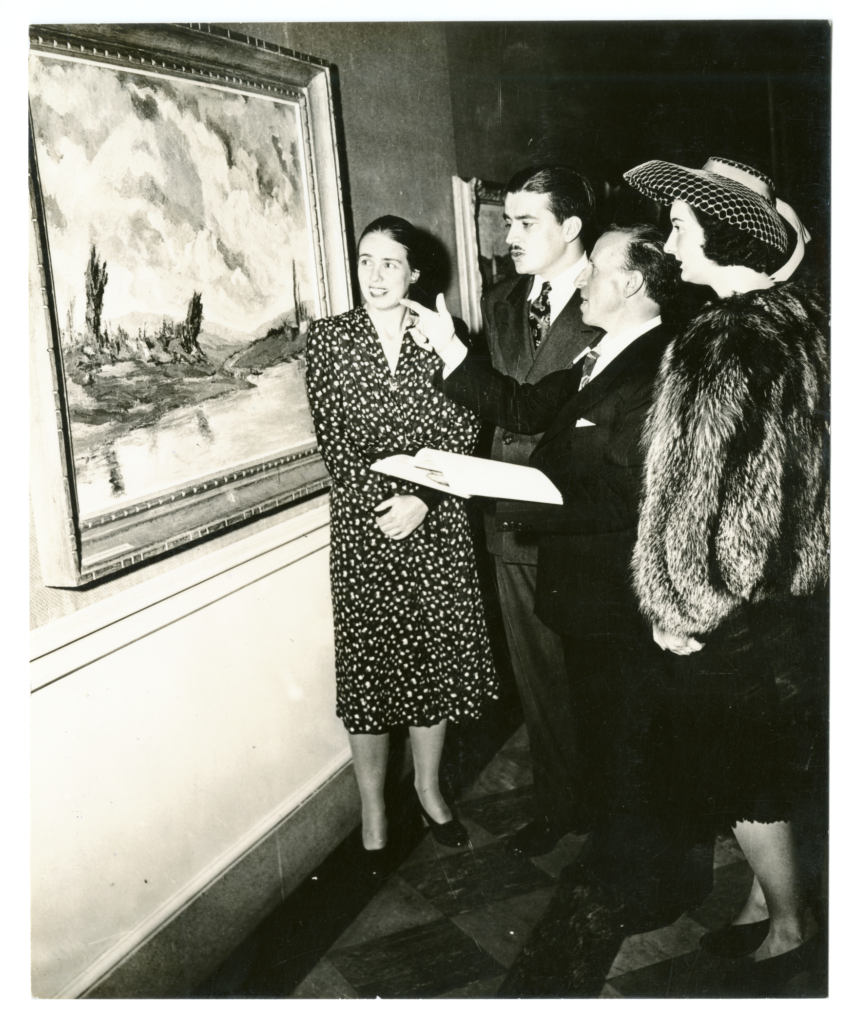
1. Opening of Chilean Contemporary Art, San Francisco Museum of Art, Civic Center. August 13, 1942, 5–7 p.m.; left to right: Grace McCann Morley, Director of the Museum; Mr. Mario Illanes, Chilean consul; Mr. Jose Perotti, commissioner of the exhibition, Mrs. Illanes. 1942; courtesy San Francisco Museum of Modern Art Archives
Reflecting on her long tenure as director of the San Francisco Museum of Modern Art, Grace McCann Morley (fig. 1) described the social role of the museum as a defender of modern art and artists:
One
of the values of such an institution as the Museum of Modern Art [in New York]
in a great way, and the San Francisco Museum of Art in a small way, is to give
leadership for points of view that are somewhat confused by popular prejudice
and lack of knowledge. . . . [MoMA] has always resisted attacks from the
uninformed on modern art, whether inspired by political bias, by ignorance, by
economic rivalry. . . . They defended art and artists and insisted judgment
should depend on art value alone, and so did we.1
While Morley may defer to New York’s MoMA in this statement, under her leadership SFMOMA was every bit as groundbreaking.2 Her steadfast dedication to supporting underrepresented and suppressed modern art and artists, including local artists, women artists, and artists of color, was integral to her early vision for SFMOMA, which she stressed through the museum’s innovative exhibition schedule and other programming.
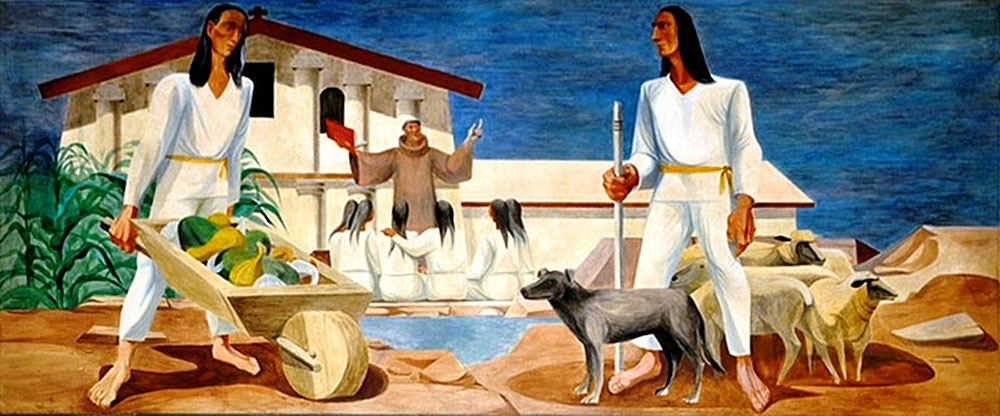
2. Anton Refregier, Preaching and Farming at Mission Dolores (1946); former Rincon Annex Post Office, San Francisco; used with permission of the United States Postal Service®
In the same conversation, Morley reflected on a specific historical moment that for her encapsulated SFMOMA’s mission. In 1953 the House Committee on Public Works deliberated the destruction of Anton Refregier’s controversial series of twenty-seven murals representing the history of San Francisco.3 Refregier had received the commission in 1940, near the end of the federally funded art movement known as the Public Works of Art Project (PWAP), part of President Franklin D. Roosevelt’s New Deal agenda, but World War II interrupted and Refregier did not begin work until 1946. His decidedly progressive murals, situated in the Rincon Hill Post Office, embody a critical reflection on the city’s history. Panels such as Beating the Chinese demonstrate the persecution and violence suffered by Chinese Americans after their integral contributions to the construction of the transcontinental railroad, and Preaching and Farming at Mission Dolores shows Spanish exploitation of Native Americans for labor (fig. 2). In 1953, the murals, featuring such scenes of colonial oppression and violent prejudice, were described by the committee as “definitely subversive and designed to spread communistic propaganda.”4
Morley and the SFMOMA community quickly came to their defense. Morley recalled, “One of the illustrations of what . . . the San Francisco Museum of Art represents is that controversy over the Refregier murals. . . . That’s really an interesting episode in San Francisco art history.”5 She wrote to the committee with a passionate statement in defense of the work, and solicited support from colleagues across the nation, including Nelson Rockefeller and MoMA’s founding director, Alfred H. Barr Jr. SFMOMA became San Francisco’s central point for rallying support around the murals. “And that,” Morley said, “is one of the things that a museum, especially a museum of contemporary art . . . must consider part of its function—to take a stand on the art questions of the day, to furnish information, to give leadership.”6 For her, Refregier’s murals represented an indispensable example of San Francisco’s artistic heritage and development.
Born in Berkeley in 1900, Morley attended the University of California, Berkeley, and then received a scholarship to study at the Sorbonne in Paris, where she earned a doctoral degree in French literature and art. When she returned to California in 1933, after serving as the first general curator at the Cincinnati Art Museum, she described the Bay Area as a culturally remote part of the United States, barely touched by the avant-garde until Diego Rivera painted his first US murals there in 1930 and 1931. Rivera’s presence inspired a robust mural movement, which intensified thanks to Roosevelt’s federally sponsored art programs. Through SFMOMA’s early exhibitions, regularly organized around important donations made by patrons such as Albert Bender and William Gerstle, Morley emphasized the significance of Rivera’s local impact.7 In a 1936 conference paper she asserted, “If I had to name the art in which California leads in the moment, I believe I should say fresco.”8
According to Morley, the mural movement represented a cultural awakening, and specifically the birth of modern art in San Francisco: “I think it should be noted that [in the Bay Area], you had a more extensive development of mural painting in general, and especially of fresco painting, than elsewhere.”9 When artists and colleagues visited San Francisco in the 1940s, she took them on tours to see the Coit Tower murals, the murals and mosaics by Hilaire Hiler and Sargent Johnson at Aquatic Park, and Rivera’s Making of a Fresco, Showing the Building of a City at the California School of Fine Arts (now the San Francisco Art Institute) and Allegory of California at the Stock Exchange (now the City Club of San Francisco). Morley believed that San Francisco’s murals represented a crucial part of the region’s artistic development.10
Refregier’s commission played a vital role within that history. The murals of Coit Tower, which faced censorship in 1934 for Communist content, were the first PWAP-sponsored project in San Francisco.11 Refregier’s commission was the last, and according to Morley, “the finest.”12 She feared that the destruction of the latter represented something more than a threat to San Francisco’s art historical legacy: “There were indications that if these murals were destroyed, a movement to remove from public buildings all art good and bad, would sweep the country . . . based on prejudice and on opposition to contemporary art in general. . . . That kind of hysterical prejudice . . . had to be stopped. We felt it here.”13
Saving Refregier’s murals meant defending all modern art and artists from censorship and persecution. Morley often used her directorial role as a platform to speak out against the prejudice faced by modern art and artists. When Kathleen Carroll from the New York design firm McMillen Inc. wrote to her, inquiring about arranging an exhibition of work by “Negro artists, painters and sculptors,” Morley informed Carroll that SFMOMA’s exhibitions and events were not segregated: African American artists such as Sargent Johnson and Thelma Johnson Streat, both influential local figures, regularly attended events and exhibited their work in group shows at SFMOMA.14 Streat, a dancer as well as a painter, also debuted her choreography at SFMOMA in 1946.15 When SFMOMA had opened in the Veterans Building in 1935, the institution possessed no funds for acquisitions and relied upon patrons for donations; Albert Bender donated ten drawings and sculptures by Johnson, establishing a strong presence for the artist in the permanent collection.16
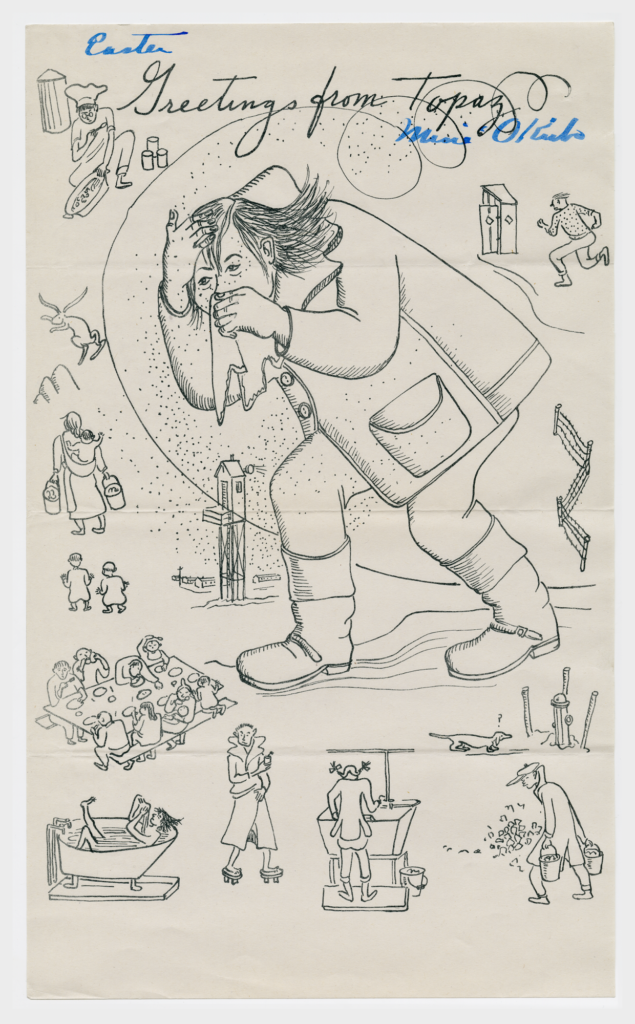
3. Miné Okubo to Grace McCann Morley, April 1943; courtesy San Francisco Museum of Modern Art Archives.
Between 1940 and 1941, while the US government was investigating the loyalty of Japanese Americans living on the West Coast and in Hawaii, Morley dedicated three exhibitions to paintings and gouaches by the local Japanese American artist Miné Okubo. Okubo had studied at University of California, Berkeley, and like Streat, worked alongside Rivera on his mural Pan American Unity: The Marriage of Artistic Expression of the North and South of this Continent in the “Art in Action” section of the 1940 Golden Gate International Exposition.17 While interned at Tanforan Assembly and then the Topaz Relocation Center between 1942 and 1944, Okubo documented her experiences of camp life through drawings that contested stereotypes of Japanese Americans as well as government censorship of representations of Japanese internment, which forbade imagery of barbed wire or watchtowers.18 (In 1946 Okubo published her drawings in a graphic novel titled Citizen 13660, referencing the number assigned to her family during internment.) Morley maintained regular communication with Okubo during that period. Among their correspondence is a sheet of paper filled with Okubo’s drawings and “Greetings from Topaz” scrawled across the top of the page (fig. 3). The central figure is an internee, likely Okubo, holding a handkerchief to her nose with one hand and shielding her head from wind and rain or snow with the other. She is surrounded by an arrangement of smaller drawings revealing scenes from Topaz, including men, women, and children dining and bathing, a figure running to an outhouse, and others engaging in labor, along with a watchtower and barbed-wire fences.19 When the Argentine painter Emilio Pettoruti asked Morley to send questionnaires to local artists in order to help him collect information for a series of newspaper articles, which he planned to publish in Argentina, Morley sent one to Okubo at Topaz, providing her with another platform to express her experience.20
During Morley’s tenure as director, women artists maintained a strong presence in SFMOMA’s collection and exhibitions. Morley consistently featured women artists in both individual and group exhibitions, including annuals dedicated to the San Francisco Society of Women Artists. Between 1935 and 1940, SFMOMA devoted more than forty single-artist exhibitions to women, including Ruth Armer, Julia Codesido, Aline Liebman, Henrietta Shore, and Susi Singer. This number stands in striking contrast to MoMA in New York, where women were rarely featured in exhibitions. MoMA opened in 1929 and did not organize its first one-woman show, Josephine Joy: Romantic Painter, until 1942.
Contemporaries: Beatrice Judd Ryan, Jermayne MacAgy, and Ninfa Valvo
Morley was just one of many notable women who supported modern art in San Francisco. In 1925, before Morley returned to the Bay Area, Beatrice “Bea” Judd Ryan realized that San Francisco’s galleries and museums were reluctant to exhibit modern art. With the encouragement of her friend, the artist Maynard Dixon, Ryan opened a cooperative nonprofit gallery in order to secure an exhibition space for modern art in the Bay Area.21 Born in Melbourne, Australia, Ryan grew up on the peninsula south of San Francisco and graduated in one of the earliest classes at Stanford University. When her husband, Arthur Ryan, a wealthy New York real estate salesman, died in 1916,22 she returned to San Francisco with their two children and became an “enthusiastic, energetic, zestful entrepreneur of West Coast artists.”23 Ryan’s Galerie Beaux Arts is credited as the first US venue to show Diego Rivera’s work.24 Through her gallery, she supported young local artists, including many women, such as Streat, Dorr Bothwell, and Adaline Kent. After Galerie Beaux Arts closed in 1932, Ryan served as California state director of exhibits for the Works Progress Administration’s Federal Art Project until 1938. She was San Francisco’s chairperson of National Art Week in 1940, and she organized the “Art in Action” section of the Golden Gate International Exposition with the artist Helen Bruton.25 In 1945 Ryan founded Rotunda Gallery within the Union Square department store City of Paris as a “centrally located” place where local artists could show and sell their work.26
In 1943, at the age of twenty-nine, Jermayne Smart MacAgy became the acting director of the California Palace of the Legion of Honor and the youngest museum director in the United States.27 While MacAgy organized exhibitions at the Legion of Honor, her husband, Douglas MacAgy, served under Morley as a general curator at SFMOMA and then became the director of the California School of Fine Arts, where he recruited Mark Rothko and Clyfford Still as teachers.28 Jermayne MacAgy trained in Paul J. Sachs’s revolutionary museology program at Harvard’s Fogg Museum and earned a doctoral degree from Western Reserve University, where she wrote her dissertation on folk art.29 While occupying numerous positions at the Legion of Honor—curator in charge of the educational program, assistant director, and acting director in 1946 and again from 1950 to 1951—she arranged hundreds of innovative didactic exhibitions and taught museum classes such as “Patronage and Propaganda in the Arts.”30
MacAgy supported West Coast artists as a curator, organizing early and important shows dedicated to Still and Mark Tobey, and developed her own private collection, which she later donated in part to SFMOMA.31 SFMOMA organized an exhibition around her donation of West Coast Surrealist paintings in 1984.32 After MacAgy’s death, San Francisco Chronicle art critic Alfred Frankenstein wrote: “In her days as assistant director of the Legion of Honor, [MacAgy] did more for the rising school of Bay Area artists than anyone else in our museum world.”33 MacAgy thrived with the support of the Legion’s benefactor and founder, another powerful woman and proponent of modern art in San Francisco, Alma de Bretteville Spreckels.34 MacAgy’s exhibitions received praise from critics across the country, most notably for their unconventional, innovative content and design. New York Times critic Aline B. Saarinen praised her 1949 exhibition Trompe L’oeil, which surveyed eye-fooling paintings from the eighteenth to the twentieth centuries, as “memorable and entertaining” and lamented, “It is unfortunate that the California Palace show cannot circulate widely.”35 In 1955 MacAgy left the Legion of Honor and became the first director of the Contemporary Arts Museum Houston, where she curated shows such as Totems Not Taboo (1959), which demonstrated the indebtedness of European modernism to African and Oceanic art.36
In 1941 Ninfa Valvo became the curator of painting and sculpture at what is now the de Young Museum in San Francisco, where she organized exhibitions dedicated to local artists, including Frank Lobdell and David Park.37 Born in San Francisco, Valvo had developed a passion for the arts through her father, a barber from Palermo, Italy, who often took her to the San Francisco Opera.38 After graduating from high school, Valvo worked as a typist and then served in the navy as a Yeomanette during World War I. In 1931 an employment agency recruited her to assist Lloyd Rollins, then director of the de Young and the Legion of Honor. While working in San Francisco’s museums, Valvo took art classes at the California School of Fine Arts, where she eventually received an honorary doctorate. After Walter Heil succeeded Rollins, Valvo maintained her position, and when the de Young and the Legion of Honor divided into two distinct institutions, she followed Heil to the de Young. In 1938 she traveled to Europe as Heil’s envoy, securing his selections for the European section of the 1939 Golden Gate International Exposition. There she met New York gallery owner Curt Valentin, who “introduced her to the new movements in art, opening her eyes and spirit to contemporary artistic directions.”39
Valvo demonstrated her new passion for contemporary art at the de Young, where she arranged as many as thirty-six exhibitions annually, often disregarding public opinion and Heil’s conservative tastes. On one occasion, a friend warned her that she had “gone too far” when Heil demanded that she remove Sonia Gechtoff’s Abstract Expressionist paintings from the de Young’s walls. “Get it down!” he demanded, but Valvo resisted, and eventually one day she observed Heil “peering into the galleries” at the contemporary paintings he had initially deemed “lousy stuff.”40 She noted, “If it was an important show, an advance show, I knew it would shock people and make them angry, but I thought it was the responsibility of the museum to bring the public the best they could get of what is being done today, so people would know rather [than] judge it.”41 Upon Valvo’s retirement, Frankenstein wrote in the San Francisco Chronicle, “Very few painters and sculptors of first class rank have emerged in the Bay Region during the last quarter-century without her help . . . and all these reputations have stuck.”42
Expanding Modern Art
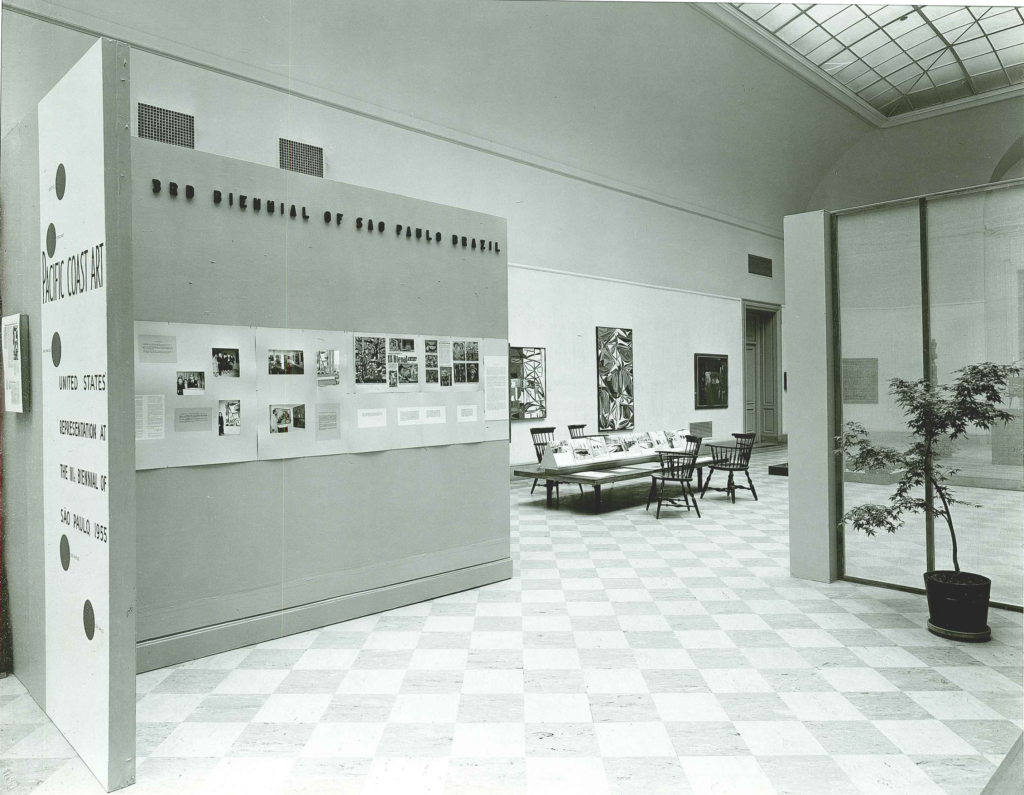
4. Installation view of Pacific Coast Art (the São Paulo show) installed at SFMOMA
Like MacAgy, Ryan, and Valvo, Morley championed local artists. During her tenure at SFMOMA, Bay Area artists were continually the focus of individual, group, and annual exhibitions. She often wrote to New York colleagues, such as MoMA curator Dorothy Miller, to promote such artists as Dorr Bothwell, Claire Falkenstein, and David Park.43 When Morley was invited to curate the US section of the third Bienal de São Paulo in 1955, she used the event as an opportunity to introduce national and international audiences to artists from California, Oregon, and Washington.44 Her exhibition, Pacific Coast Art, corrected omissions from MoMA’s 1951 and 1953 São Paulo showings, which had largely excluded West Coast artists (fig. 4).45 Of the fifty-eight artists selected for MoMA’s 1951 exhibition, which aimed to present a “panoramic view” of US art, only three were from the West Coast: Morris Graves, Robert Boardman Howard, and Mark Tobey. Morley often worried about the careers of local artists and saw Pacific Coast Art as a solution to their exclusion from exhibitions at institutions such as MoMA. She wrote to Frankenstein:
Here, far from New York dealers and the opportunity to get invited to big Eastern shows, they are under a considerable disadvantage—they do not get the encouragement and they do not get the incentive that continuous competition for recognition and sale on the New York art market provides. This show should open wider opportunities for at least some of them. I have great confidence in the abilities of the group as a whole.46
Through Pacific Coast Art, Morley gave Bay Area artists like Ruth Asawa, Roy De Forest, and Park their first opportunity to exhibit internationally.
Pacific Coast Art achieved critical acclaim in Brazil, where it received a “warmer reception than had been accorded the two previous shows of more ‘important’ artists” arranged by MoMA.47 After it closed in São Paulo, it traveled throughout the United States to the Cincinnati Art Museum, Colorado Springs Fine Arts Center, Dayton Art Institute, the Institute of Contemporary Art in Boston, and the Walker Art Center in Minneapolis, and continued to receive praise from critics. When Aline B. Saarinen discovered that Pacific Coast Art would not be exhibited in New York, she wrote in the New York Times, “Isn’t there some New York museum or gallery which is willing to play host to a show primarily made up of artists little known nationally who still did us proud internationally as a country of artistic vitality?”48 Even though New York audiences did not have an opportunity to view the exhibition, Morley considered the show a success because it “made forcibly the point intended: art produced in regional centers, far from New York, the country’s art market and usual source for exhibitions, represents an important aspect of art in the United States.”49 Further, for Morley, the success of Pacific Coast Art in São Paulo emphasized “the necessity of finding a way to have the richness of such regional production adequately reflected in national art activity.”50
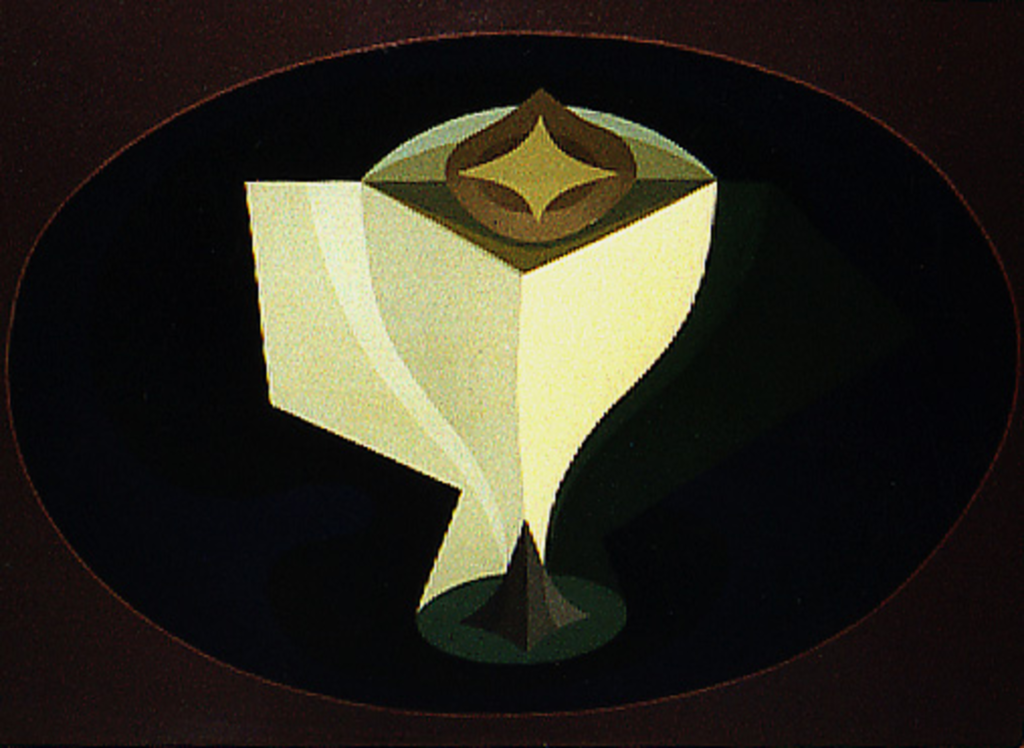
5. Emilio Pettoruti, Coparmónica, 1937; collection SFMOMA, Purchase; © Estate of Emilio Pettoruti
In addition to promoting local artists, Morley expanded upon San Francisco’s investment in Rivera and Mexican art, and developed a progressive series of exhibitions dedicated to Latin American art, including the traveling survey exhibition Contemporary Latin American Art (1942–48). Simultaneously she assembled one of the earliest collections devoted to modern Latin American art in the United States.51 While her colleagues generally considered Latin American art a tributary of European developments in modernism, through exhibitions and museum publications Morley asserted that Central America, South America, and the Caribbean were vital regions for the avant-garde. Between 1935 and 1940 she established a presence for Rivera at SFMOMA, and then directed the public’s attention to the art of Bolivia, Colombia, and Peru through exhibitions focusing on Luís Alberto Acuña, Julia Codesido, and Antonio Sotomayor.52 She strengthened the museum’s investment in modern Latin American art while planning the Central and South American section of the 1940 Golden Gate International Exposition and serving as an advisor for the Office of Inter-American Affairs during World War II. In 1941 Morley organized a series of exhibitions and lectures combating stereotypes representing Latin America as a homogenous region and asserting that “diversity is the important thing.” She often reminded her colleagues, “Each country has developed its contemporary art in its own way, each lies apart from every other, there are complex currents in the countries themselves. In some countries, there are several art centers, not only one, and all those things must be taken into account.”53
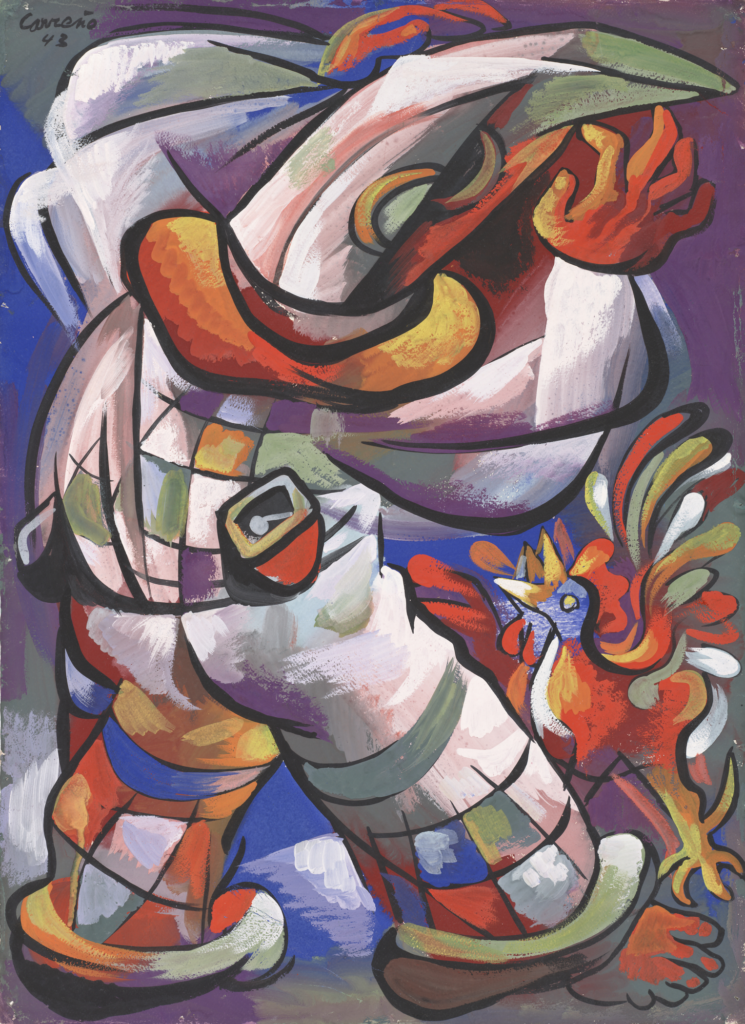
6. Mario Carreño, Afro-Cuban Dancer, 1943; collection SFMOMA, Gift of the Women's Board of the San Francisco Museum of Art; © Estate of Mario Carreño / Artists Rights Society (ARS), New York
Stanton Catlin, the first director of the Center for Inter-American Relations (now the Americas Society) described Morley as “one of the first collectors of an across-the-board kind, to know the quality of what was going on in Mexico and South America.”54 In the early 1940s Morley gave lectures on Latin American art throughout the United States, and used the honoraria she received to develop what she called the Latin American Purchase Fund, dedicated to building a diverse and representative collection of modern Latin American art at SFMOMA. Through the fund, she acquired works such as Emilio Pettoruti’s Coparmónica (1931) (fig. 5) and cultivated local interest in Latin American art, which inspired SFMOMA’s Women’s Board to also make significant purchases such as Mario Carreño’s Afro-Cuban Dancer (1943) (fig. 6). In 1942 Morley organized an exhibition of Pettoruti’s work that traveled throughout the country (fig. 7). When Morley struggled to secure a New York venue for Emilio Pettoruti of Argentina because curators and critics such as Barr and Lincoln Kirstein dismissed Pettoruti’s work as derivative, “old hat,” and exhibiting “the ghost of [Juan] Gris,” she criticized their shortsightedness.55 She consistently challenged others’ tendencies to overlook abstract paintings that had not been “consecrated with European approval.”56 Pettoruti had indeed worked alongside the Cubist painter Gris in France, but Morley argued that he made substantial contributions to modernism, especially after he returned to Argentina in 1924, where he established modern art through his own artistic practice as well as his role as the director of a progressive regional museum in La Plata.57
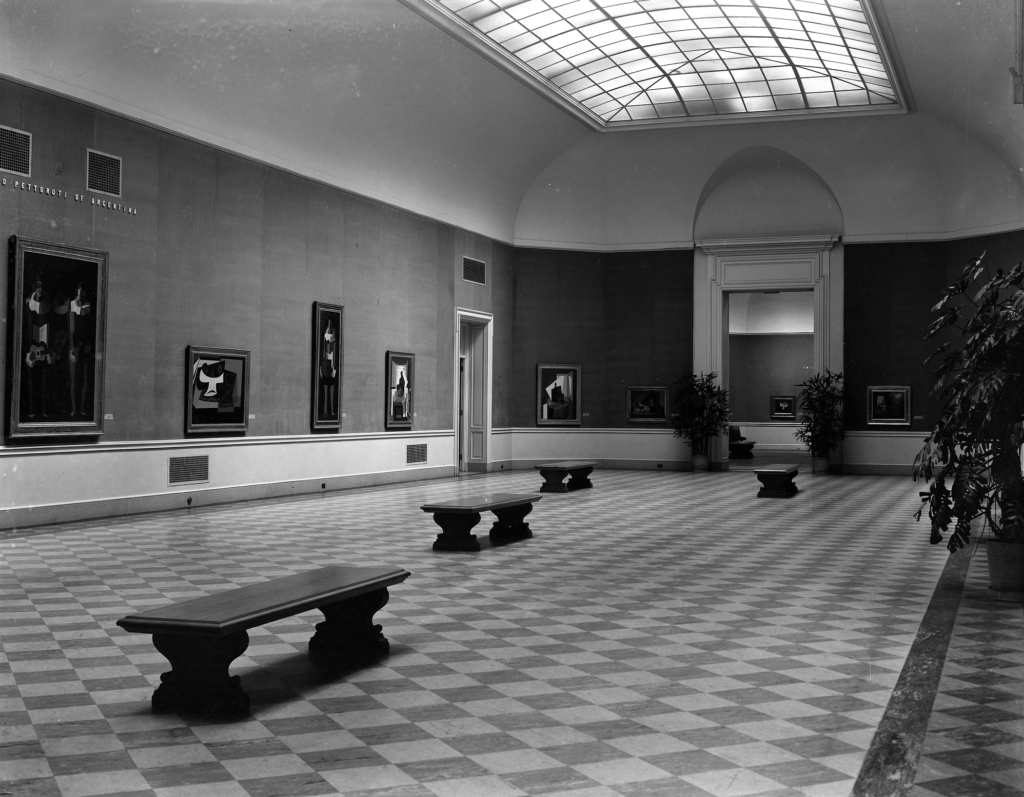
7. Installation view of Paintings by Emilio Pettoruti, September 22, 1942-January 30, 1943. Courtesy San Francisco Museum of Modern Art Archives.
By supporting marginalized artists and challenging the conventional taste of her colleagues, Grace McCann Morley established a dynamic and inclusive program of exhibitions and events at SFMOMA that exerted influence well beyond the confines of San Francisco proper. While criticizing his reluctant approval of South American art, Morley boldly wrote to Barr, a figure often credited with defining modern art in the United States, “I think perhaps that I am more widely curious than you. I like to know what is going on in the contemporary field everywhere.”58 Morley’s curiosity about new forms of contemporary art and her conviction that modern museums should “take a stand on the art questions of the day” benefited underrepresented and persecuted artists who found in her a champion for their work. SFMOMA’s visitors also benefited, as they gained access to a revolutionary interpretation of modern art that contested prejudice, bias, and conservativism. Morley’s radical belief that museums of modern art have a special ability—an obligation, even—to mobilize activism and social change within communities such as San Francisco serves as an example for contemporary museums today.
Notes
- Grace Morley and Suzanne B. Riess, Grace L. McCann Morley: Art, Artists, Museums, and the San Francisco Museum of Art: An Interview (Berkeley: University of California, General Library, Regional Cultural History Project, 1960), 127–28.
- Throughout this essay I will refer to SFMOMA by its name today, although during Morley’s tenure it was called the San Francisco Museum of Art (SFMA).
- For more on the controversy and trial surrounding Refregier’s murals, see Gray Brechin, “Politics and Modernism: The Trial of the Rincon Annex Murals,” in On the Edge of America: California Modernist Art, 1900–1950, ed. Paul J. Karlstrom (Berkeley: University of California Press, 1996), 69–93.
- Ibid., 79.
- Morley and Riess, Grace L. McCann Morley, 127.
- Brechin, “Politics and Modernism,” 79.
- Bender and Gerstle were instrumental in coordinating the artist’s mural commissions in San Francisco, and both donated substantial gifts of work by Rivera and other Mexican artists to SFMOMA. Bender gave SFMOMA approximately fifty drawings, oils, pastels, and watercolors by Rivera, and Gerstle donated twenty studies for Rivera’s The Making of a Fresco Showing the Building of a City (1931). For additional information on Morley’s dedication to collecting and exhibiting Latin American art at SFMOMA, see Berit Potter, “Building a Model of Diversity: Grace McCann Morley and Collecting Modern Latin American Art in San Francisco” in The Americas Revealed: Collecting Colonial and Modern Latin American Art in the United States, ed. Edward J. Sullivan (University Park, PA: Penn State University Press, 2018).
- Paper read by Morley at a luncheon for the American Federation of the Arts, “Art Resources in California,” May 15, 1936, box 1, folder 2, San Francisco Museum of Art, Office of the Director Records, 1935–1958, San Francisco Museum of Modern Art Library and Archives (hereafter “SFMOMA Library and Archives,” omitting the collection name, unless another collection is indicated).
- Morley and Riess, Grace L. McCann Morley, 114.
- For instance, when Heinz Berggruen published a tourist booklet on art in San Francisco, Morley criticized him for not including enough information on the development of such, in particular for neglecting murals: “On the whole, I think the booklet is excellent and most attractive. The only trouble is that it doesn’t give enough attention to art developments here. I have been doing tours for visiting museum people and artists so long that I have a regular itinerary worked out, with the Coit Tower murals for the beginning the Government Projects and the Aquatic Park for the end. Fleishhacker Zoo in between if there is time. Then, also, of course, at least the Rivera fresco in the School and sometimes too the one in the Stock Exchange. For after all Rivera has had a tremendous influence on the art in this country and his career in this country began in San Francisco. All this, I think, would be interesting and certainly it would build San Francisco’s prestige as an art center.” Morley to Berggruen, August 21, 1941, box 41, folder 8, SFMOMA Library and Archives.
- See Masha Zakheim, Coit Tower, San Francisco: Its History and Art (Volcano, CA: Volcano, 2009).
- Morley and Riess, Grace L. McCann Morley, 133.
- Ibid.
- Carroll to Morley, December 15, 1941, and Morley to Carroll, October 27, 1941, both in box 37, folder 20, SFMOMA Library and Archives.
- Judy Bullington, “Thelma Johnson Streat and Cultural Synthesis on the West Coast,” American Art 19, no. 2 (Summer 2005): 100.
- For more information about Bender’s donations to SFMOMA see Erin O’Toole, “A Very Human Thing: The Arts Patronage of Albert Bender,” in San Francisco Museum of Modern Art: 75 Years of Looking Forward, ed. Janet C. Bishop et al. (San Francisco: San Francisco Museum of Modern Art, 2009), 83–89.
- Anthony Lee discusses Okubo’s involvement with painting Pan American Unity in Painting on the Left: Diego Rivera, Radical Politics, and San Francisco’s Public Murals (Berkeley: University of California Press, 1999), 193–200. “Art in Action” encouraged the public’s support for federally funded art projects by offering fairgoers the opportunity to watch artists at work. Watch Rivera, his assistants, and other artists at work in “Art in Action,” San Francisco Bay Area Television Archive, https://diva.sfsu.edu/collections/sfbatv/bundles/187038, accessed March 25, 2017.
- See for instance Xiaojing Zhou, “Spatial Construction of the ‘Enemy Race’: Miné Okubo’s Visual Strategies in Citizen 13660,” MELUS 32, no. 3 (Fall 2007): 51–73.
- Okubo to Morley, no date, box 56, folder 20, SFMOMA Library and Archives.
- “I have received your letter of June 7 with the enclosed questionnaire. I shall be very happy to fill it out but I shall not be able to send photographs of my work because all my paintings are in storage and cannot be reached for the duration.” Okubo to Morley, June 17, 1943, box 54, folder 6, SFMOMA Library and Archives.
- Donald J. Hagerty, Desert Dreams: The Art and Life of Maynard Dixon (Layton, UT: Gibbs Smith, 1993), 139.
- “Obituaries: Arthur Judd Ryan, ex-’07,” Yale Alumni Weekly 26, no. 1 (1916): 95.
- Millie Robbins, “Millie’s Column: Friend of the Arts,” San Francisco Chronicle, December 25, 1966, 4.
- Lee, Painting on the Left, 32.
- After the exposition closed, Ryan opened the Art in Action Shop in the City of Paris department store (different from the Rotunda Gallery, which she opened there later), where customers could purchase works made by local artists, including ceramics, terra-cotta sculptures, textiles, and watercolors. See Innes Bromfield, “An Exclusive Runt Full Face of Russian Hillbilly Beatrice Judd Ryan ‘Art in Action’ Maestro,” Russian Hill Runt (San Francisco), May 1, 1941, located in folder “Rotunda Gallery/City of Paris SF (Beatrice Judd Ryan) #2,” San Francisco Art Institute Library and Archives.
- “Pariscoop,” San Francisco Chronicle, February 15, 1949, 13.
- MacAgy took over when the Legion of Honor’s permanent director, Thomas Carr Howe, left San Francisco to serve in the Monuments, Fine Arts, and Archives program during World War II.
- David R. Beasley, Douglas MacAgy and the Foundations of Modern Curatorship (Simcoe, Ontario: Davus, 1998), 32–35.
- “Jermayne MacAgy: An Exhibition and a Tribute,” Art Journal 28, no. 2 (1968): 179.
- Howe remarked after MacAgy’s death, “She was extremely inventive in her ideas of installation of exhibits.” “Jermayne MacAgy Dies in Houston,” San Francisco Chronicle, February 20, 1964, 28. See also “MacAgy to Give Museum Art Class,” San Francisco Chronicle, September 24, 1941, 13.
- Howard Devree, “An Artist’s Growth,” New York Times, October 7, 1951, 119; “Dr. MacAgy Quits Legion of Honor Job,” San Francisco Chronicle, May 17, 1955, 20.
- The exhibition was titled Jermayne MacAgy.
- Alfred Frankenstein, “Modern Vigor—British Satire,” San Francisco Chronicle, March 22, 1964, 143.
- Beasley, Douglas MacAgy and the Foundations of Modern Curatorship, 19. For more information on Alma Spreckels see Bernice Scharlach, Big Alma: San Francisco’s Alma Spreckels (Berkeley: Heydey, 2015).
- Aline B. Louchheim Saarinen, “San Francisco Surveys Development of Trompe L’oeil,” New York Times, May 22, 1949, 279.
- See Katie Robinson Edwards, Midcentury Modern Art in Texas (Austin: University of Texas Press, 2014), 175.
- See Thomas Albright, Art in the San Francisco Bay Area: An Illustrated History (Berkeley: University of California Press, 1985), 12; Nancy Boas, David Park: A Painter’s Life (Berkeley: University of California Press, 2012), 211; Alfred Frankenstein, “Artists’ Friend to Retire,” San Francisco Chronicle, March 30, 1965, 43.
- Judy Stone, “The Artists Came First: The Unexpected Career of an Unusual Curator,” San Francisco Chronicle, April 5, 1965, 51.
- Ibid.
- Ibid.
- Ibid.
- Frankenstein, “Artists’ Friend to Retire.”
- See for instance Morley to Miller, December 1, 1941, box 50, folder 13, SFMOMA Library and Archives.
- Morley invited Thomas C. Colt, director of the Portland Art Museum, and Marvin C. Ross, chief curator of art at what is now known as the Los Angeles County Museum of Art, to help her make selections for the exhibition. See Grace McCann Morley, Pacific Coast Art: United States’ Representation at the IIIrd Biennial of São Paulo (San Francisco: San Francisco Museum of Art, 1956).
- Ibid., 7.
- Morley to Frankenstein, May 5, 1956, subseries 2.2: Circulating Exhibitions, 1935–1973, box D, folder 3, San Francisco Museum of Modern Art Exhibition Records, 1934–ongoing, San Francisco Museum of Modern Art Library and Archives.
- Aline B. Louchheim Saarinen, “American Art in Brazil: Western Painters Make Strong Showing in US Pavilion at São Paulo,” New York Times, September 4, 1955, 217.
- Ibid.
- Morley, Pacific Coast Art, 12.
- Ibid.
- Potter, “Building a Model of Diversity.”
- Morley also took advantage of major gifts of Mexican art made by Albert Bender and William Gerstle. See O’Toole, “A Very Human Thing,” 83–89.
- Morley to Edward Dodd of Dodd, Mead and Company Publishing, April 25, 1941, box 40, folder 11, SFMOMA Library and Archives. Dodd had inquired about publishing a text on Latin American art.
- Oral history interview with Stanton L. Catlin, July 1–September 14, 1989, Archives
of American Art, Smithsonian Institution. - Barr to Morley, November 16, 1942, Alfred H. Barr Jr. Papers, 1.61, Museum of Modern Art Archives, New York.
- Morley to René d’Harnoncourt, October 6, 1942, box 14, folder 41, SFMOMA Library and Archives.
- See Edward J. Sullivan, “Return to Argentina,” in Emilio Pettoruti (1892–1971), ed. Edward J. Sullivan, Nelly Perazzo, Mario H. Gradowczyk, and Patricia Artundo (Buenos Aires: Fundación Pettoruti, Asociación Amigos del Museo Nacional de Bellas Artes and la marca editora, 2004), 15–152.
- Morley to Barr, July 31, 1943, box 57, folder 4, SFMOMA Library and Archives.